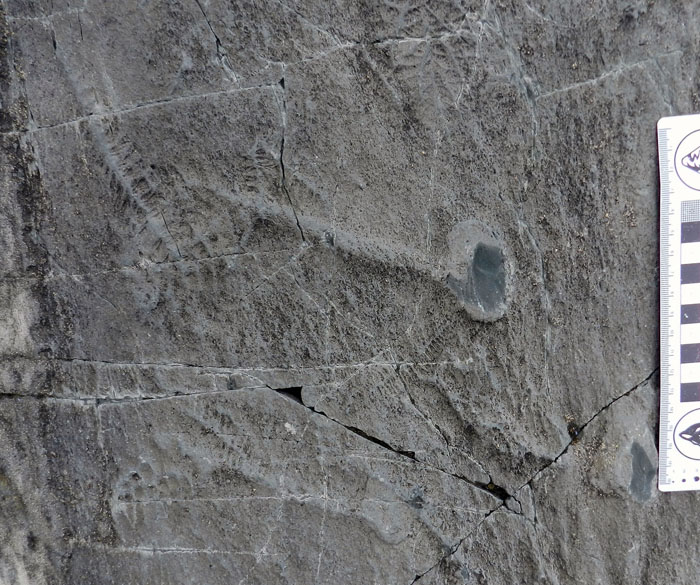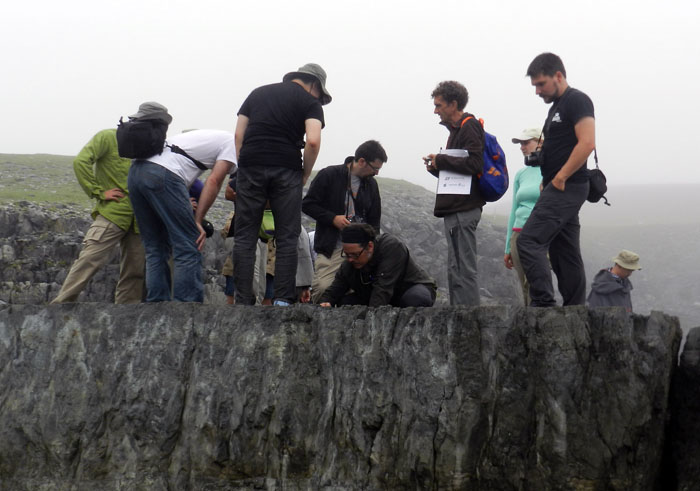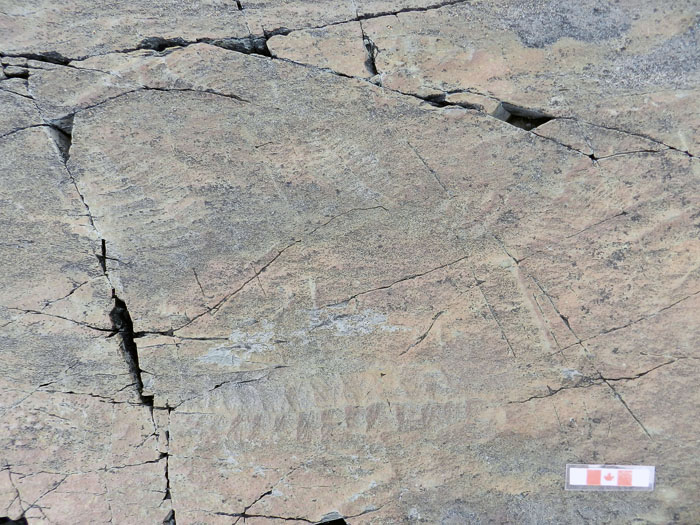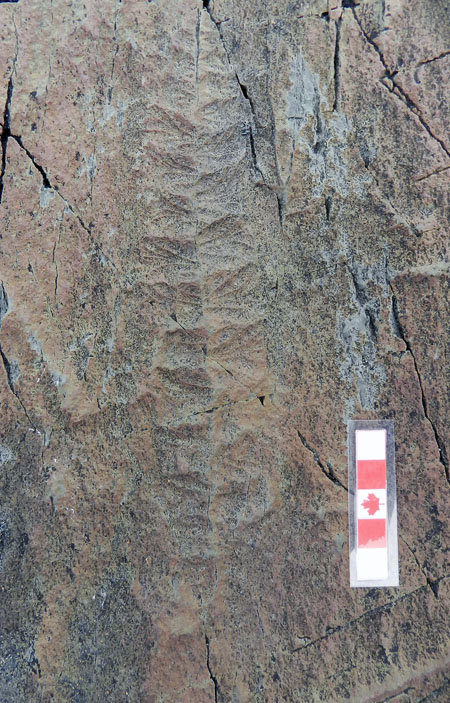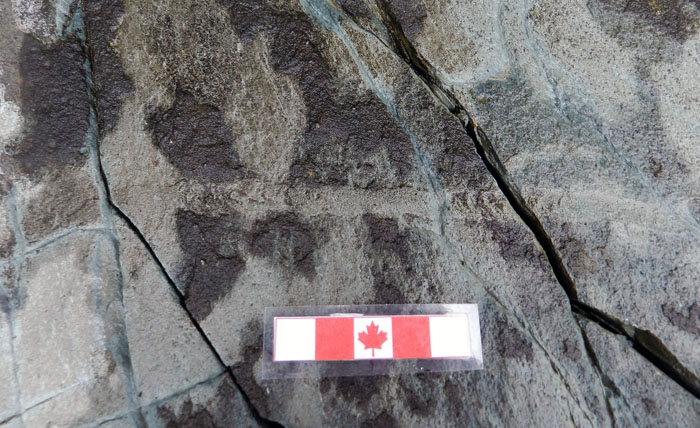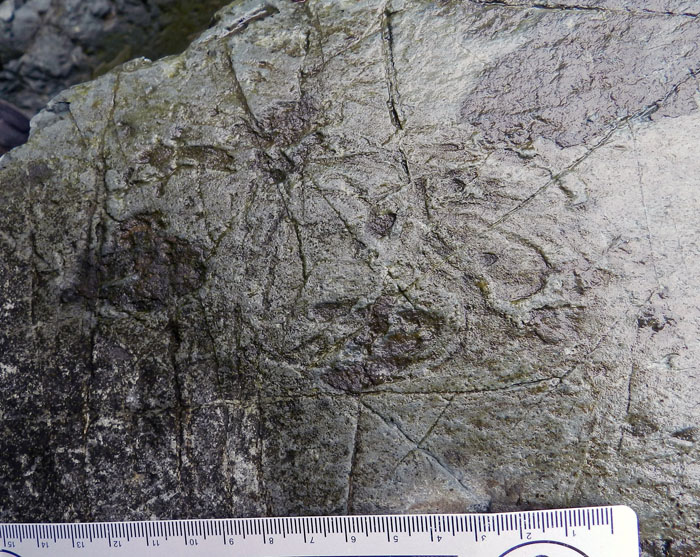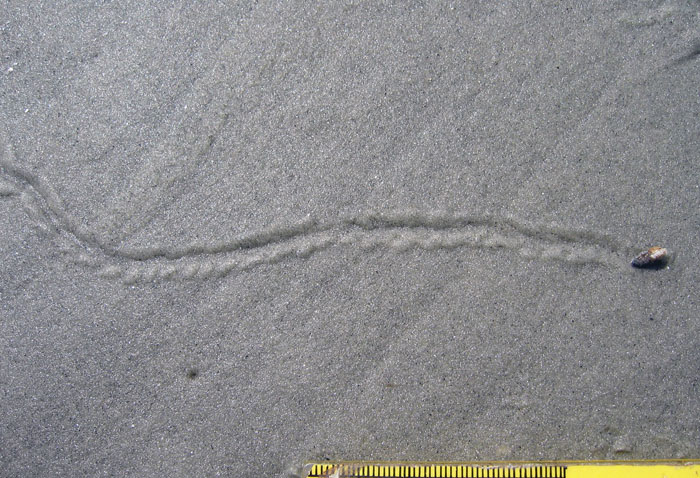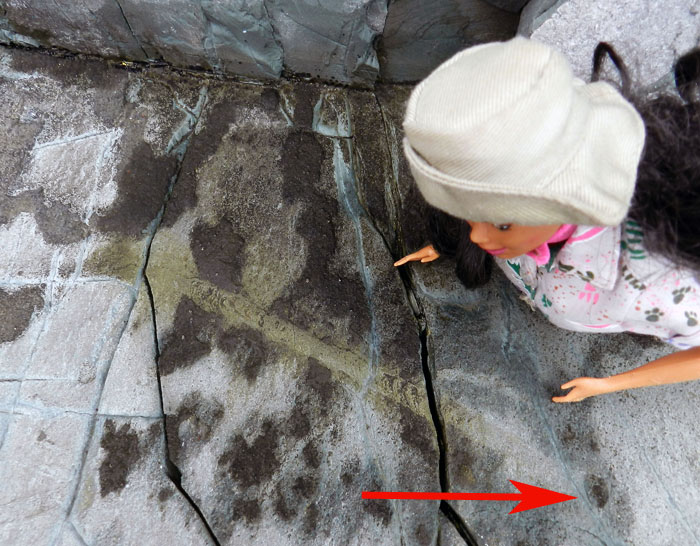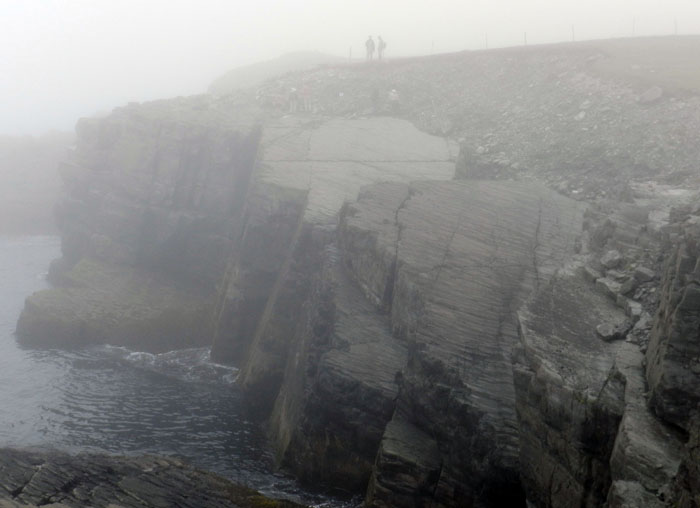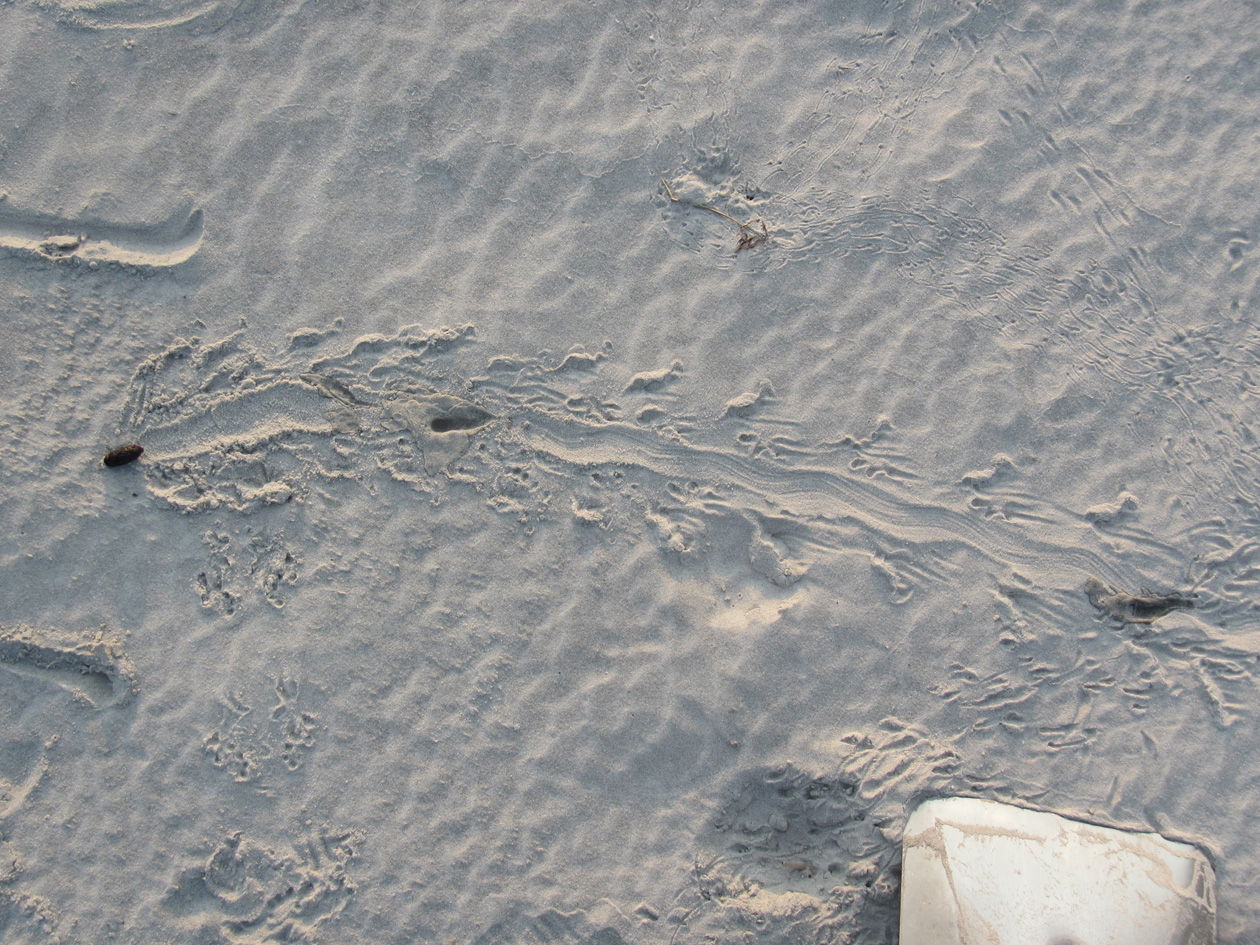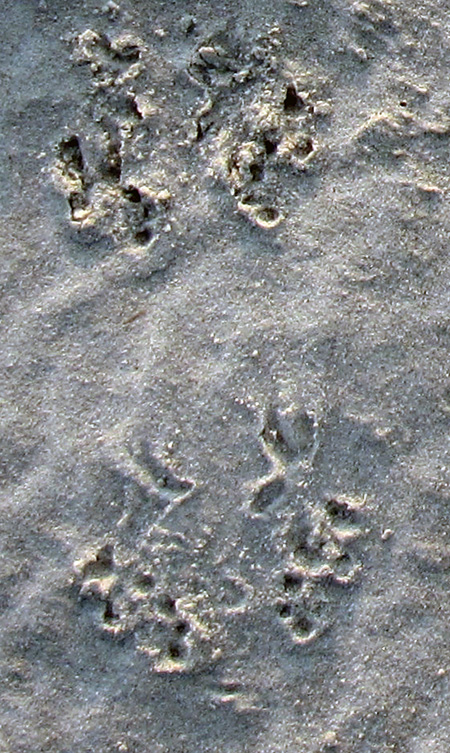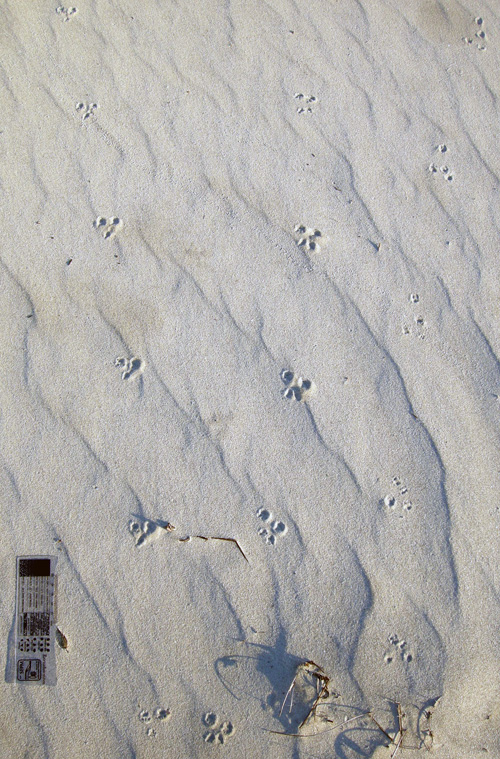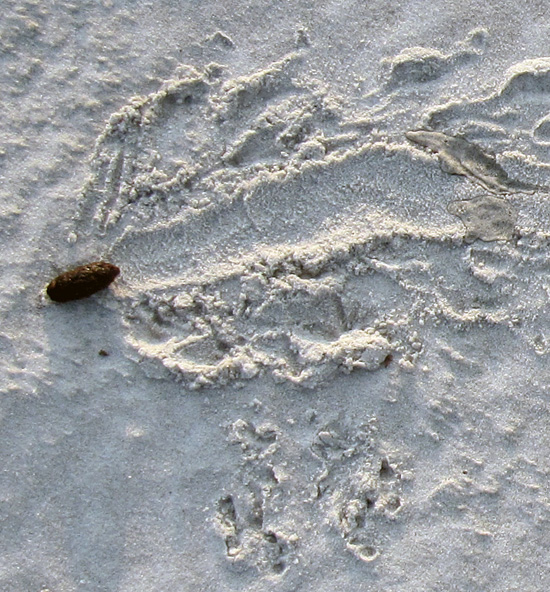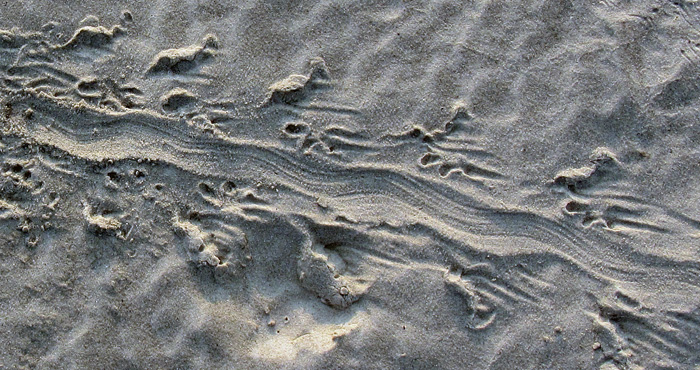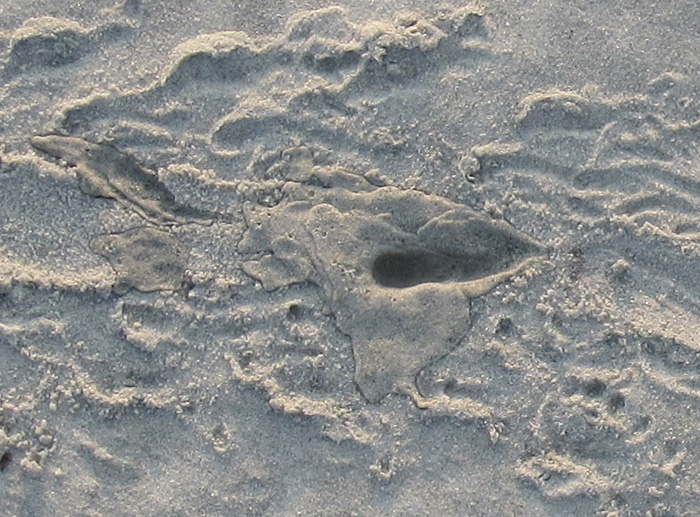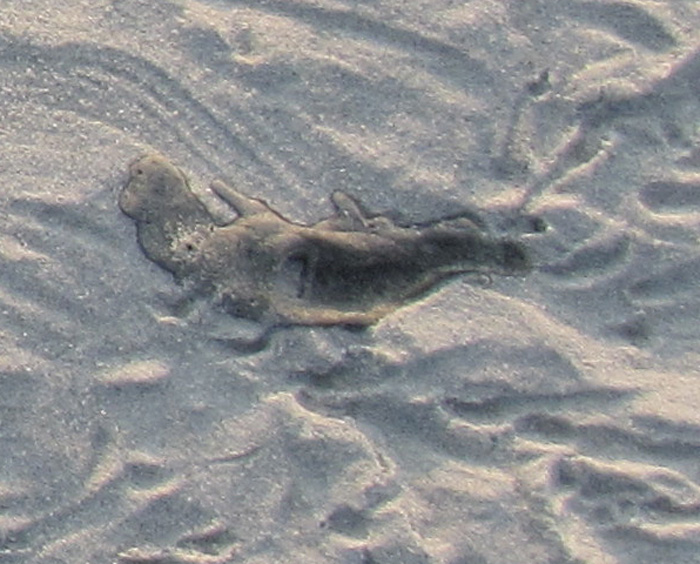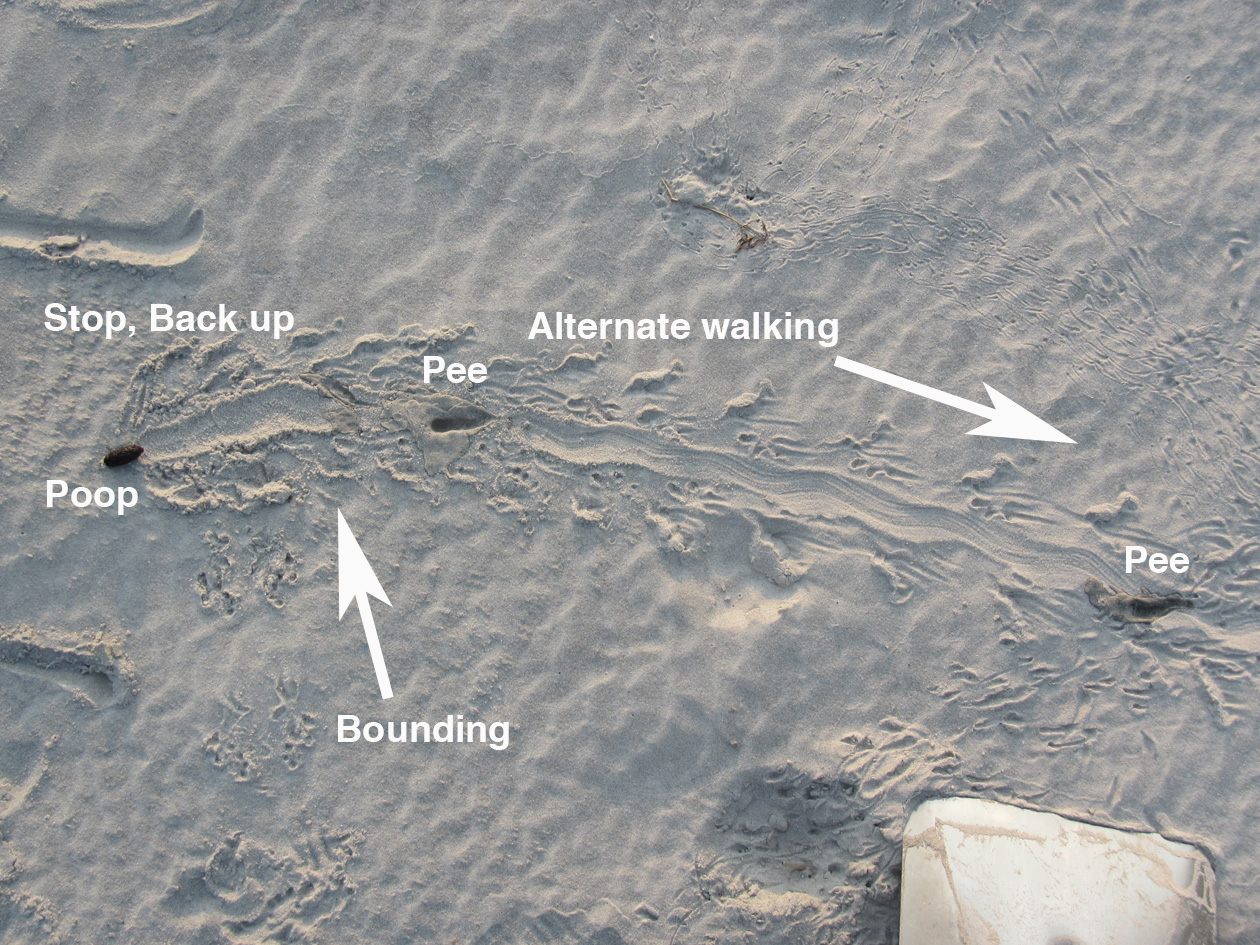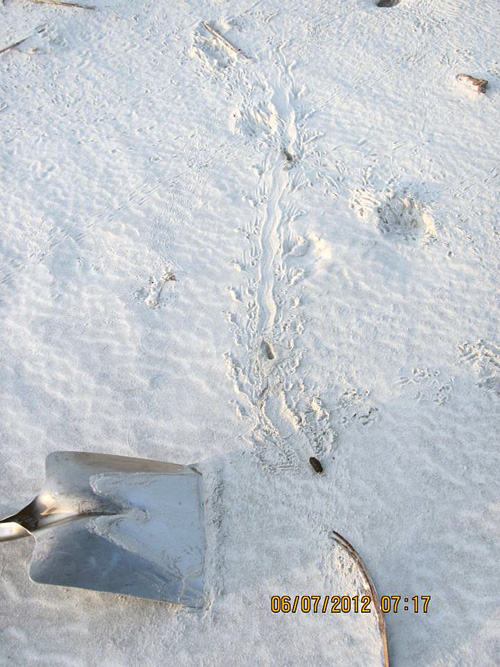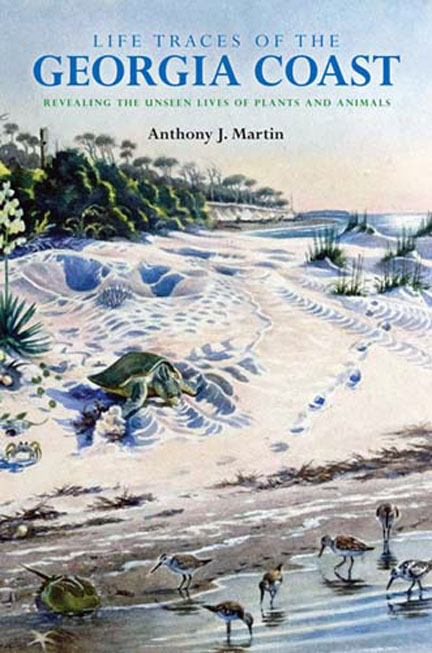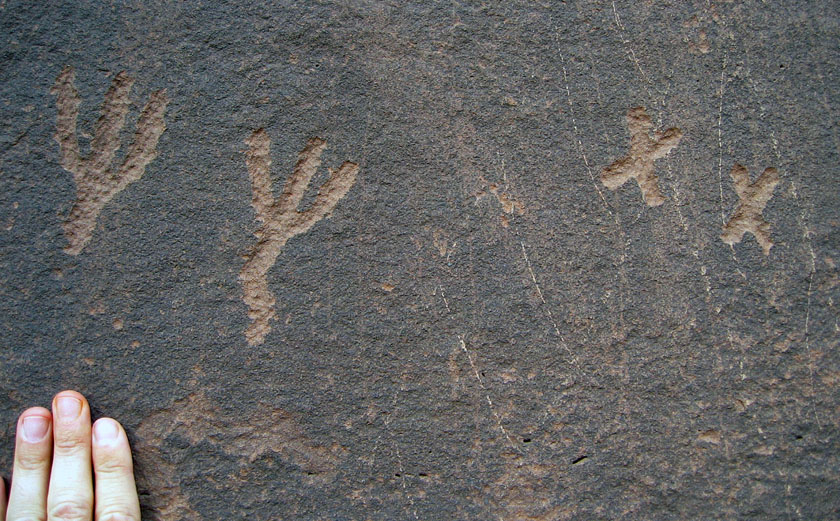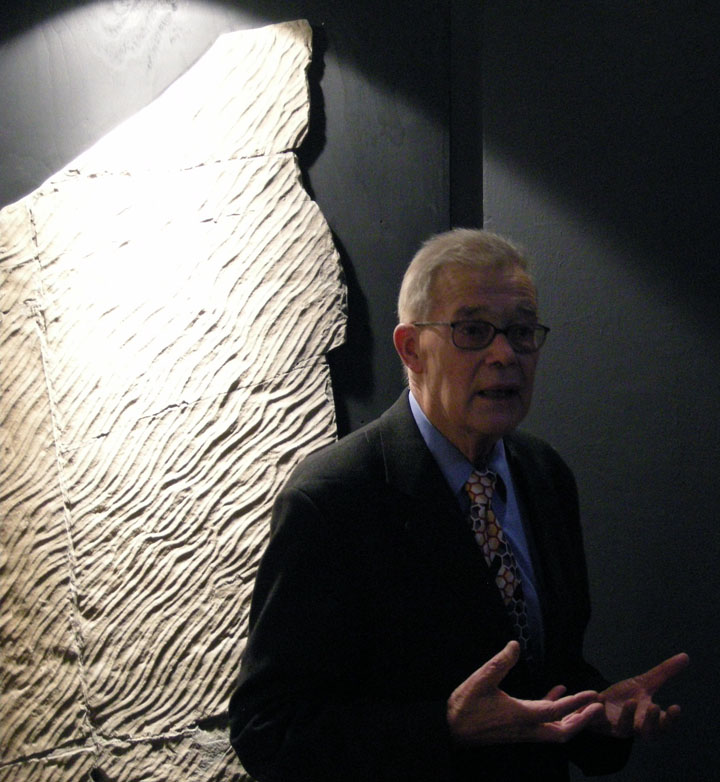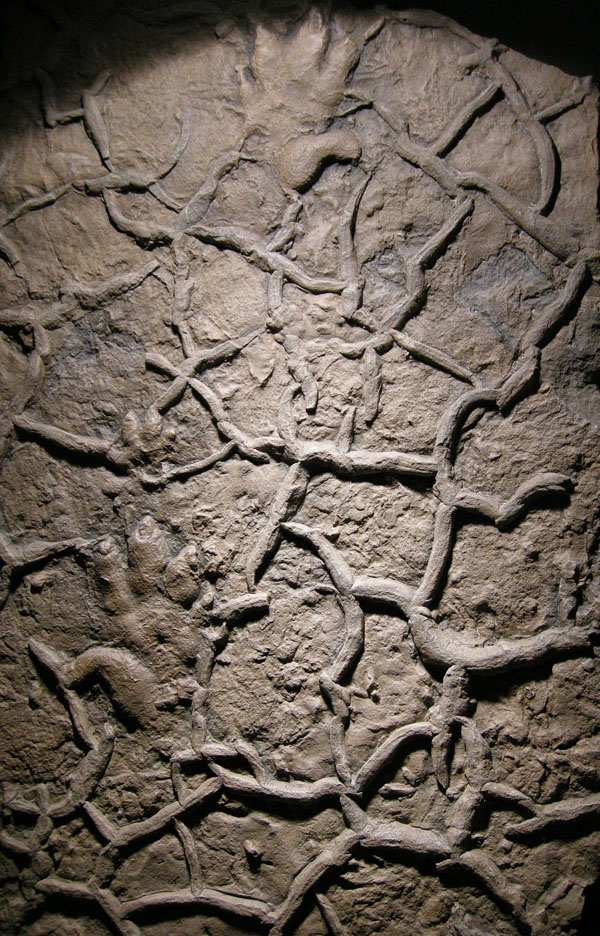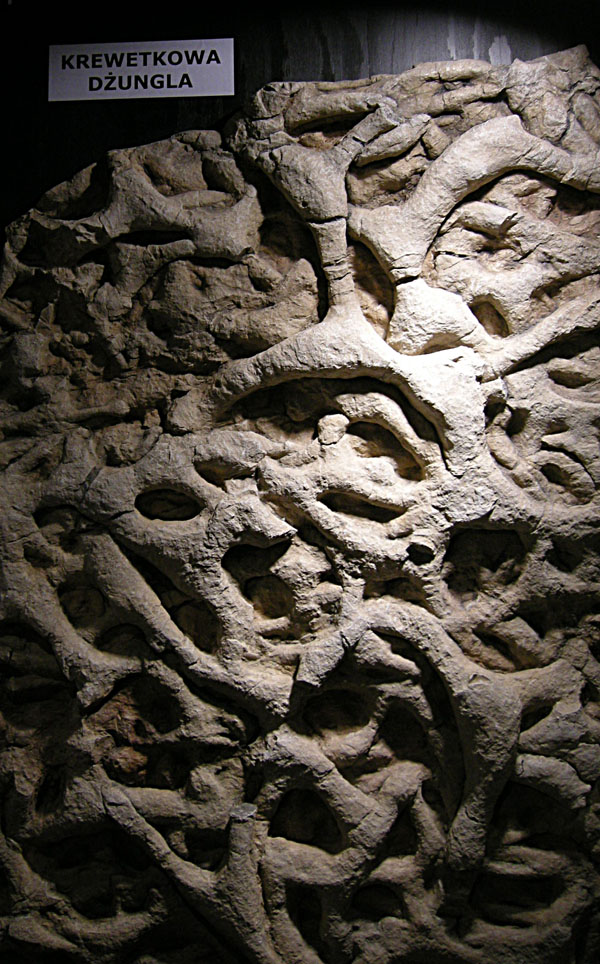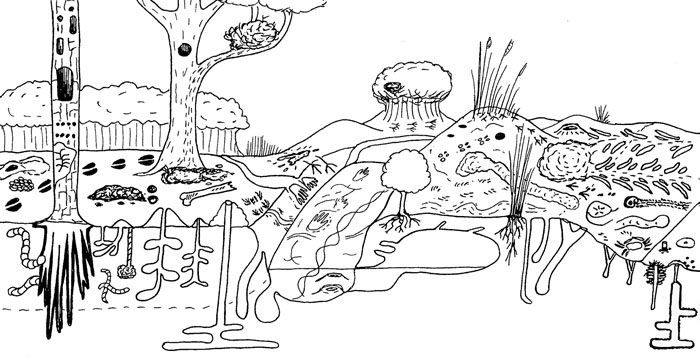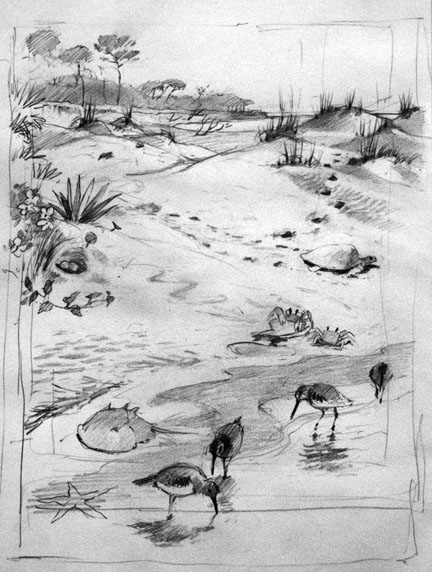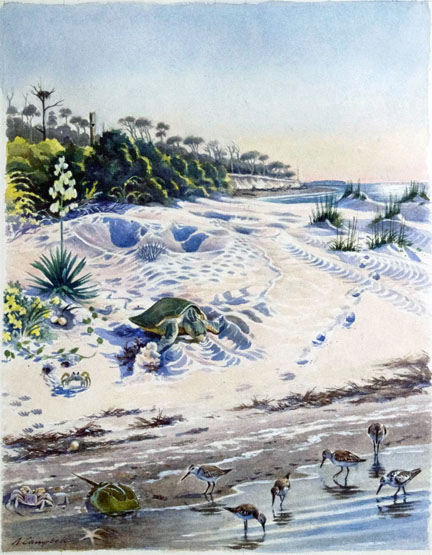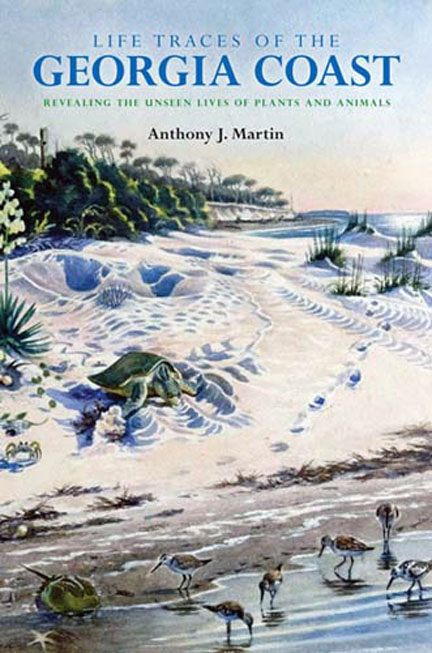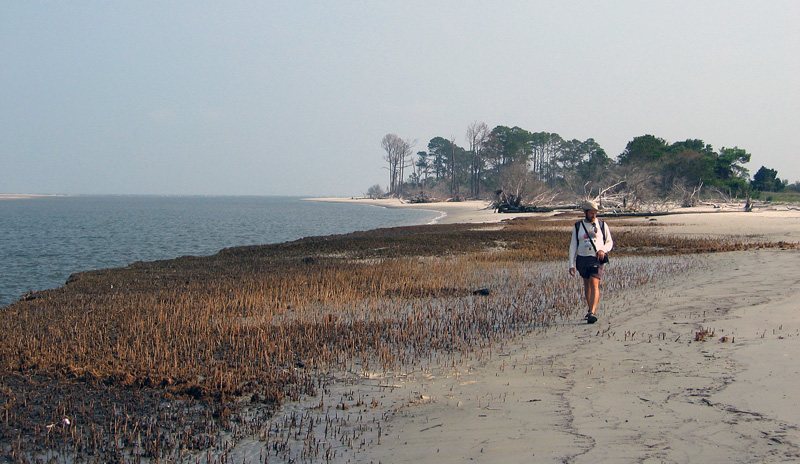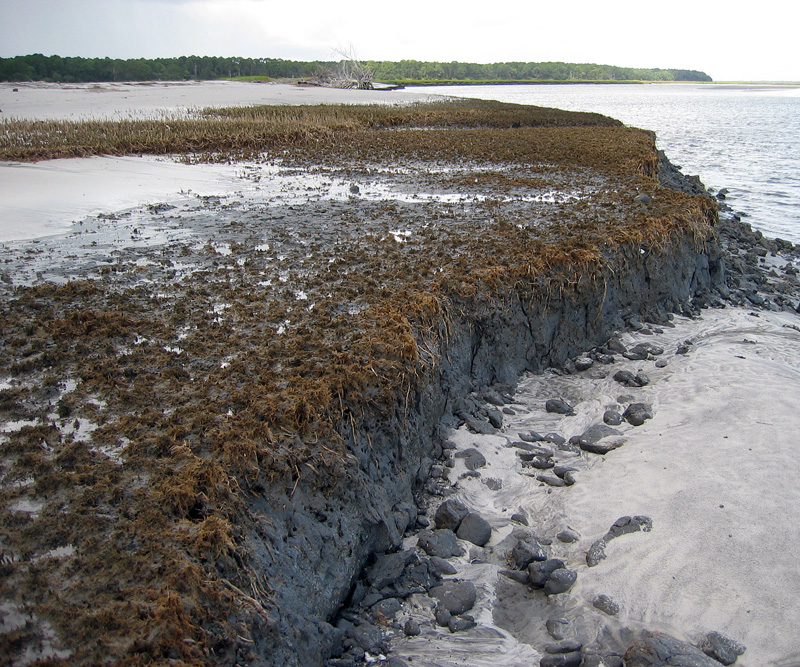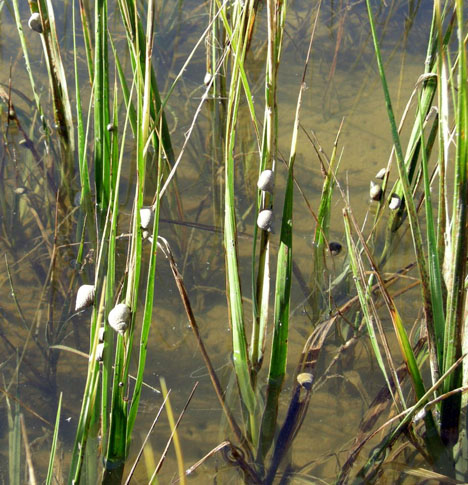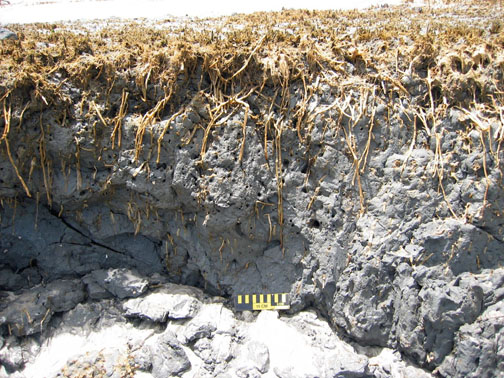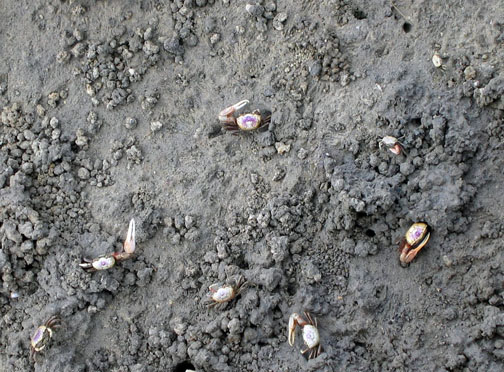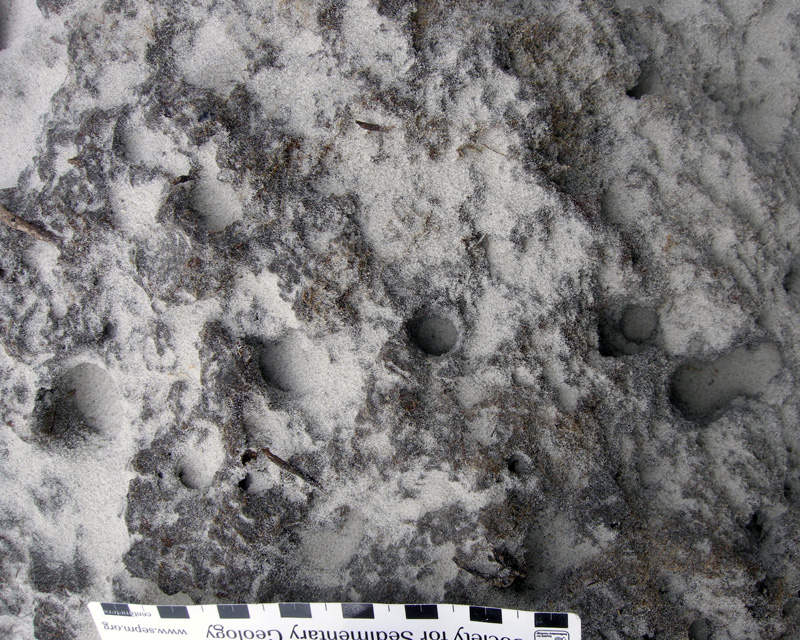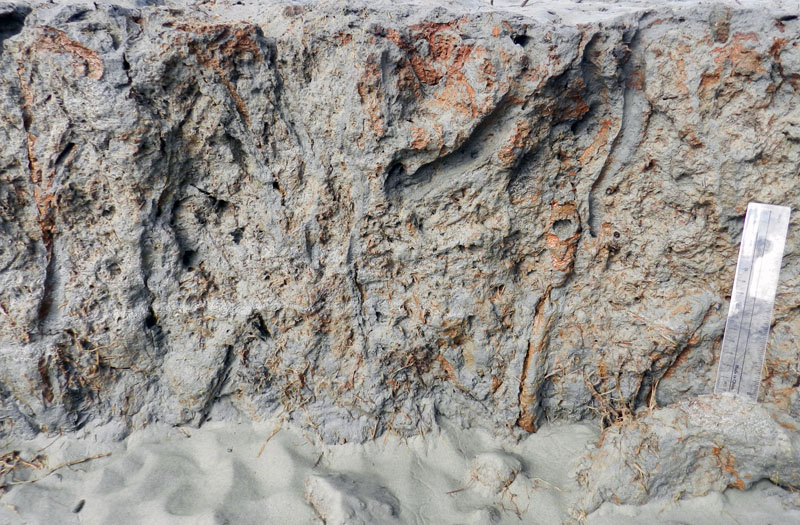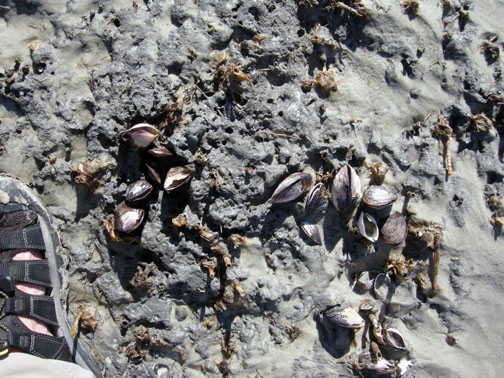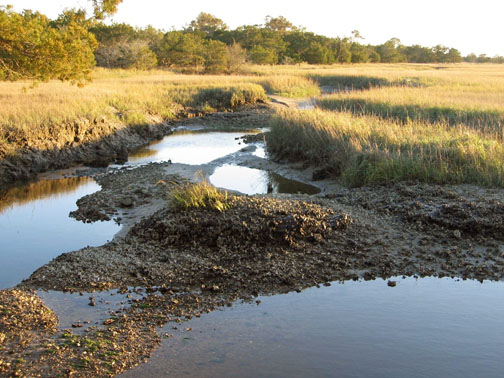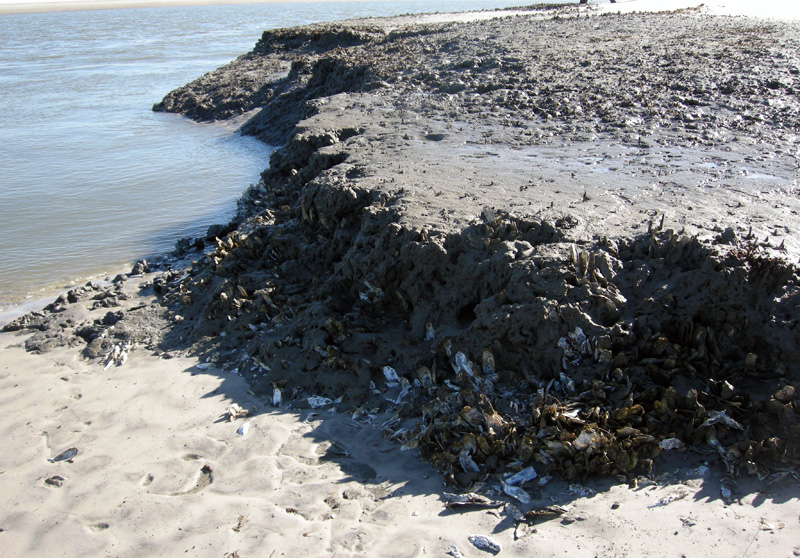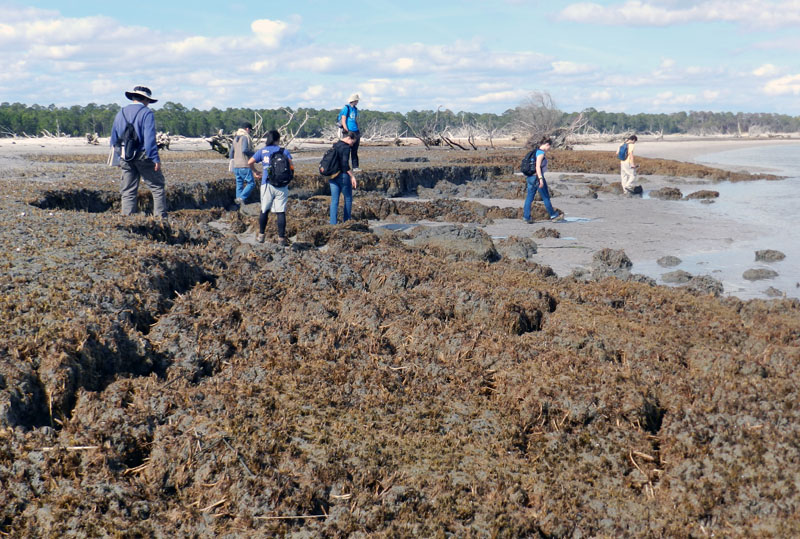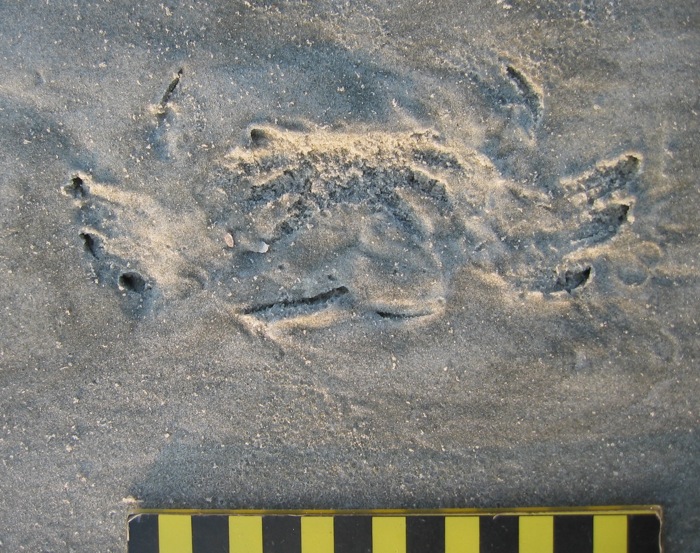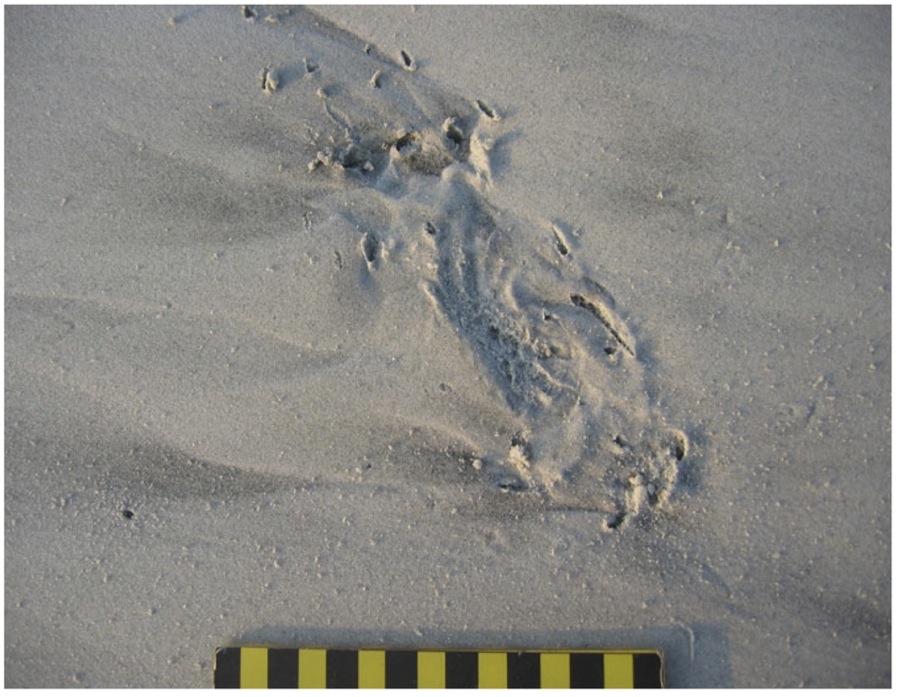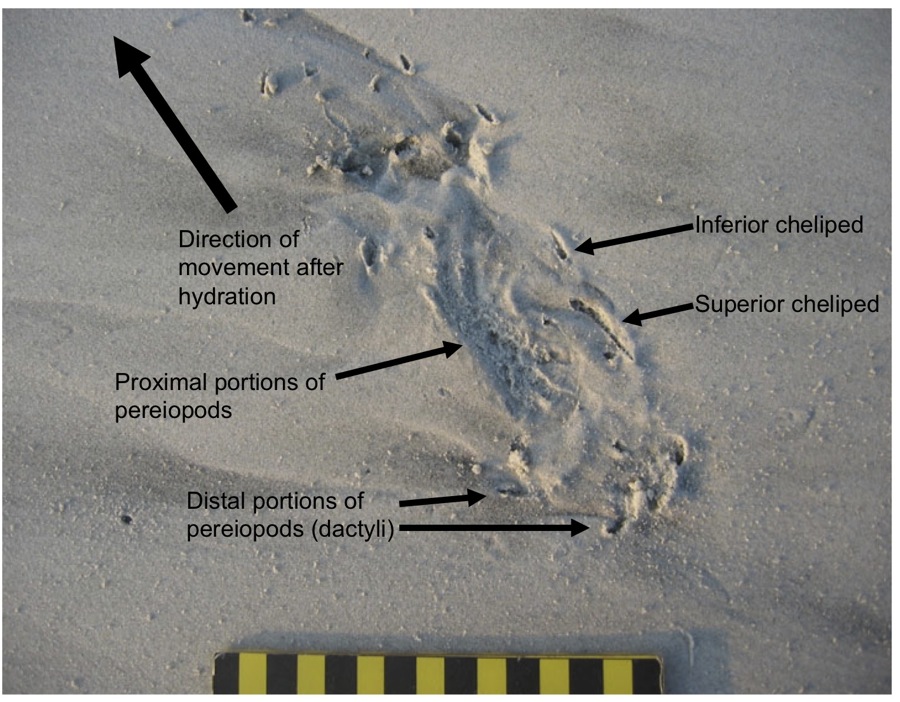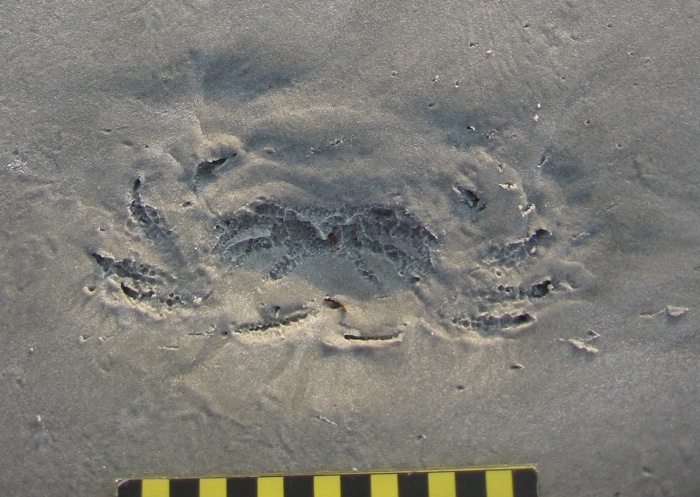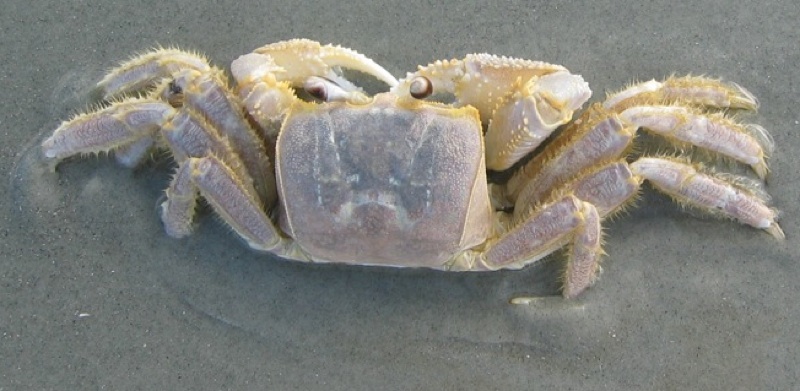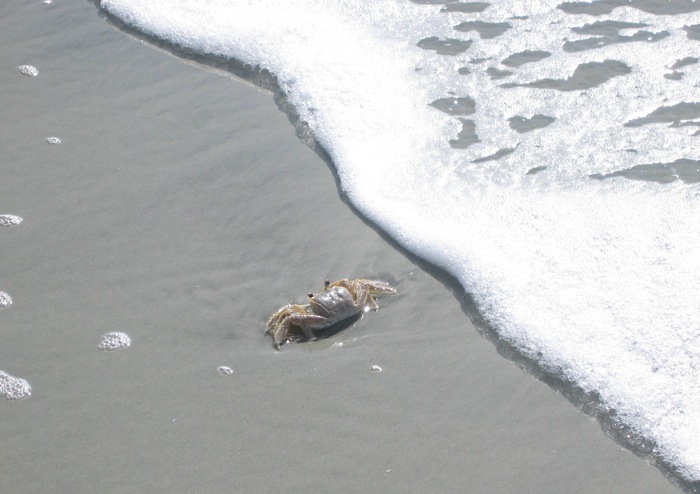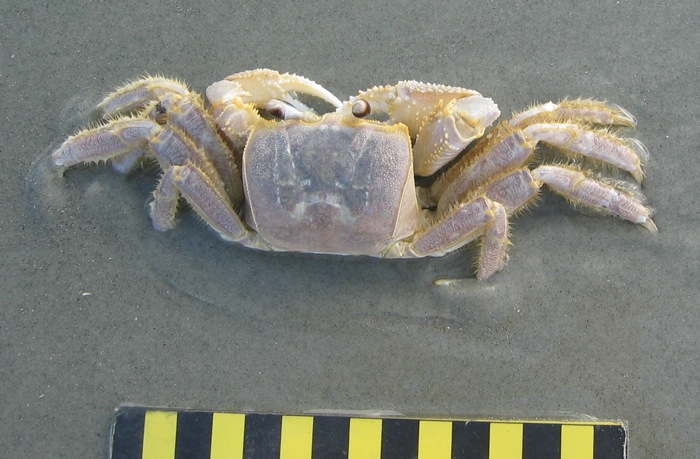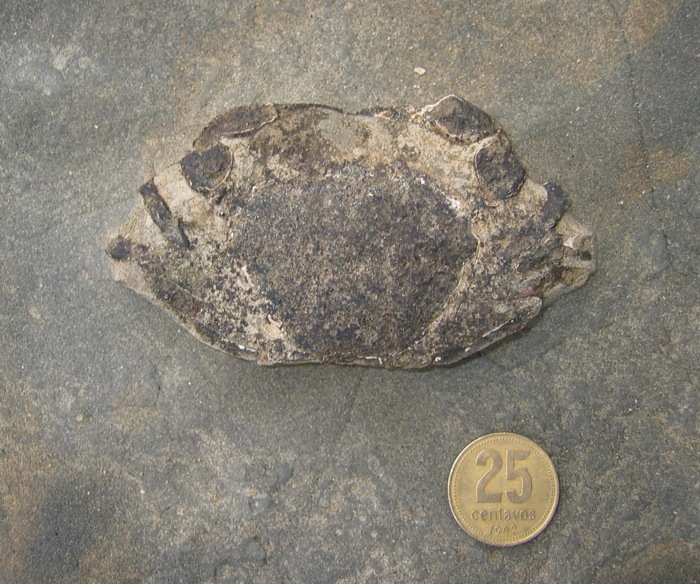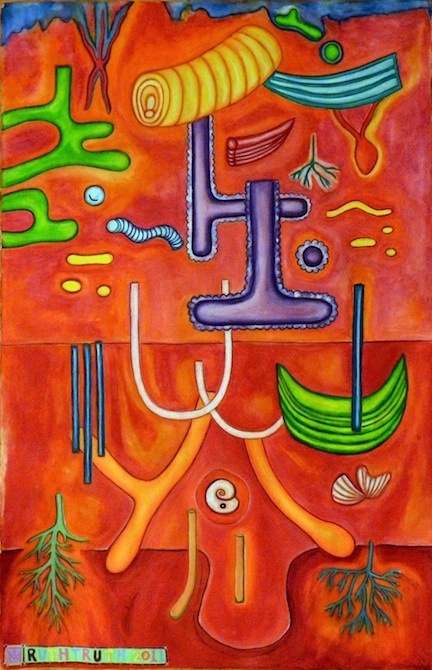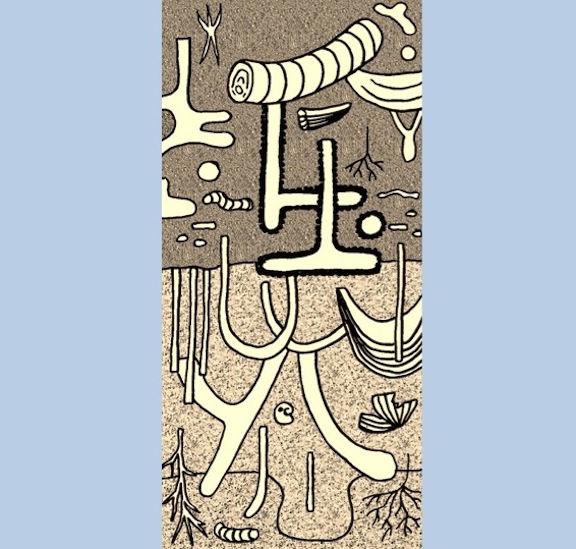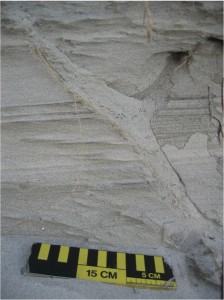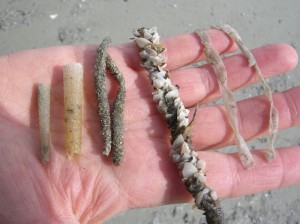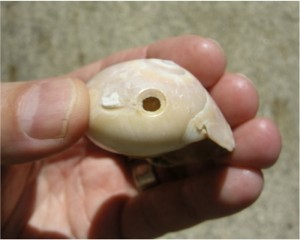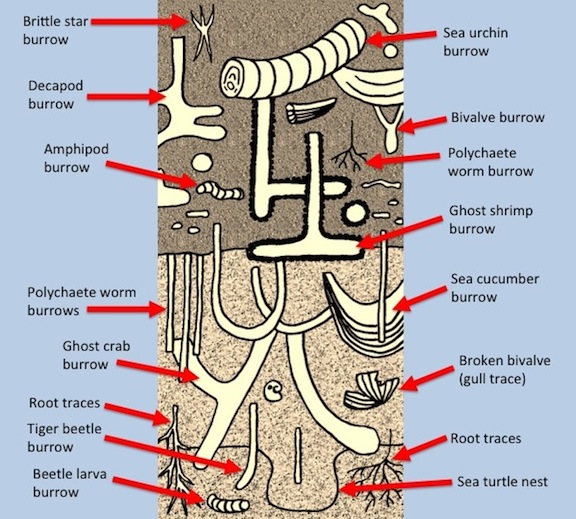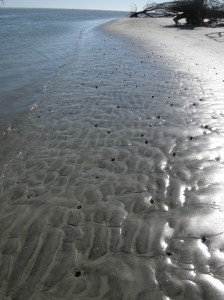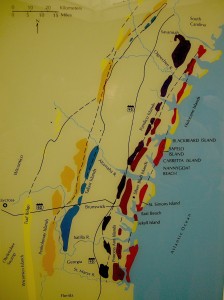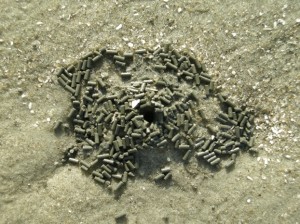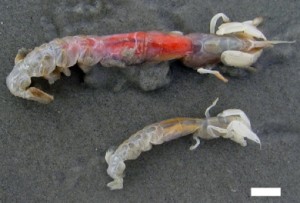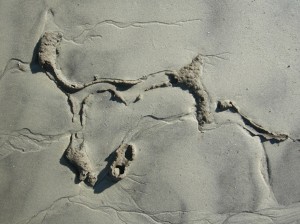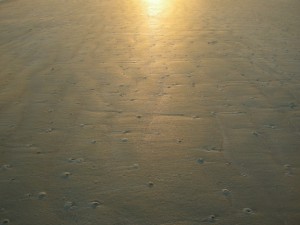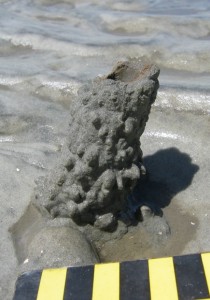(This post is the third in a series about my recent field experiences in Newfoundland, Canada in association with the International Congress on Ichnology meeting (Ichnia 2012) in August, 2012. The first dealt with the unusualness of the Ediacaran Period and the second was about the transition from the Ediacaran to the Cambrian Period for burrowing animals.)
The Ordovician Period, a time represented by rocks from 488-443 million years ago, is an old (and I mean, really old) friend of mine. In my master’s thesis, I studied Ordovician fossils from southwestern Ohio, and for my Ph.D. dissertation, I described and interpreted Ordovician trace fossils and strata in Georgia and Tennessee. Thus for the formative years of my academic career, the Ordovician had a strong presence in my life, overshadowing most other geologically inspired opportunities in my adopted home state of Georgia.
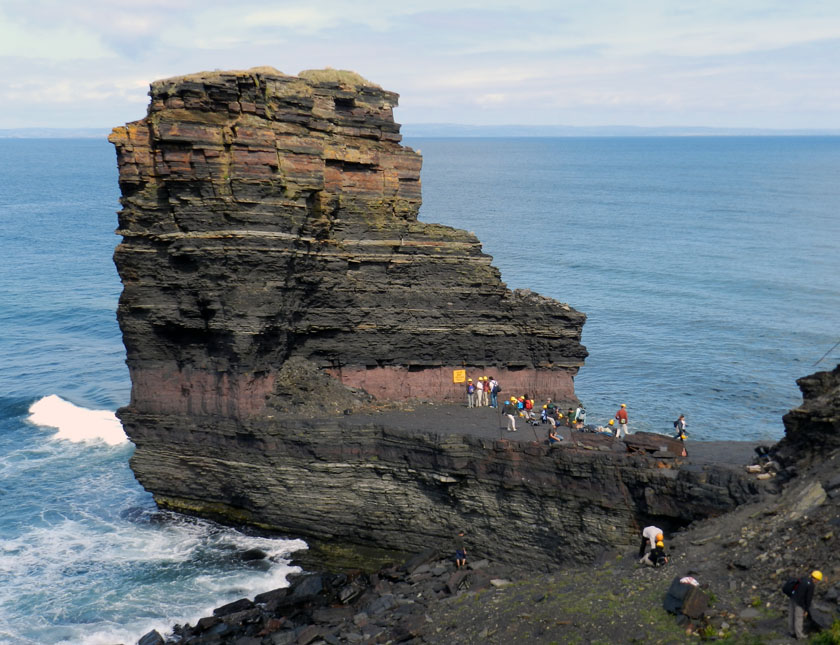 Nice outcrop, eh? It’s composed of Lower Ordovician sedimentary rocks, formed more than 450 million years ago, and is on Bell Island, just offshore from St. Johns, Newfoundland (Canada). It’s a place I had never visited before last month, but its trace fossils took me back to Georgia. How? Guess you’ll have to read some more to find out. (Photograph by Anthony Martin.)
Nice outcrop, eh? It’s composed of Lower Ordovician sedimentary rocks, formed more than 450 million years ago, and is on Bell Island, just offshore from St. Johns, Newfoundland (Canada). It’s a place I had never visited before last month, but its trace fossils took me back to Georgia. How? Guess you’ll have to read some more to find out. (Photograph by Anthony Martin.)
This Ordovician-dominated worldview contrasted with a much later focus on the present-day Georgia barrier islands. Between when I first arrived in Georgia, in 1985 through 1998, my only foray to its coast was a three-day field trip as a graduate student to Sapelo Island in 1988. Fortunately, I’ve been a more regular visitor to Sapelo and other Georgia barrier islands throughout the past 14 years or so, and my geologic perspective has accordingly traveled more than 400 million years forward to study modern plant and animal traces.
However, as I’ve embraced the present and the lessons it offers, what also happened over those years was a personal distancing from the Ordovician. This separation was unfortunate for several reasons. One is that Ordovician body and trace fossils are a mere 1.5-2 hour drive from where I live in the metropolitan Atlanta area, just south of Chattanooga, Tennessee. In contrast, the Georgia coast takes a minimum of four hours to reach by car.
Granted, northwest Georgia was part of my dissertation field area, so my leaving behind a place already prospected, poked, prodded, and otherwise inspected thoroughly more than 20 years ago is understandable and forgivable. Yet a day trip there with a colleague last spring (March 2011), along with a recent field trip to view Ordovician rocks in Newfoundland, Canada last month, reminded me of what was in my geological backyard, while also provoking new thoughts about the intersections between the Ordovician and the Georgia coast.
So what happened during those 20+ years of not studying the Ordovician rocks close to me in Georgia? Well, I gained lots more experience, went to many places with rocks and trace fossils of varying ages, and thus – I like to think – became a better ichnologist. So that leads to an imperiously pronounced statement, so please read it, take it in, and revel in its truth: Ichnology is a skill-based science.
People who study the earth sciences have an old saying, often stated during field trips to students: “The best geologist is the one who’s seen the most rocks.” The same sentiment might be applied to ichnologists. To excel as an ichnologist, it’s not your publication record (let alone impact factors of journals publishing your work), the number or size of your grants, accolades of your peers, “big-idea” review papers, erudite tomes, or any number of trappings imposed by academia that matter. What really matters in becoming a better ichnologist is how many traces you’ve seen, measured, sketched, journaled, photographed, pondered, argued over, and folded into your consciousness.
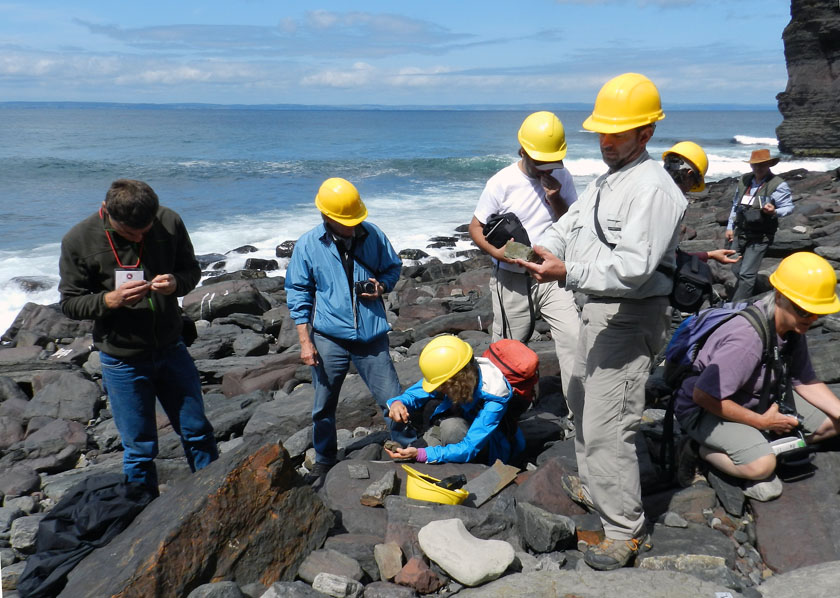 Hey, look – it’s ichnologists, trying to learn more by studying trace fossils in the field! (Photograph by Ruth Schowalter, taken on Bell Island, Newfoundland, Canada.)
Hey, look – it’s ichnologists, trying to learn more by studying trace fossils in the field! (Photograph by Ruth Schowalter, taken on Bell Island, Newfoundland, Canada.)
Sure, peer review from your colleagues is still an important part of this learning process. Otherwise, as a tracking instructor once told me and other nascent trackers, “When you always track by yourself, you’re always right.” You don’t want to be that ichnologist who gets things wrong, then insists every other ichnologist is wrong, while also imagining that they’re teeming with jealousy over your brilliance. You know, the “they laughed at Galileo, too” fallacy.
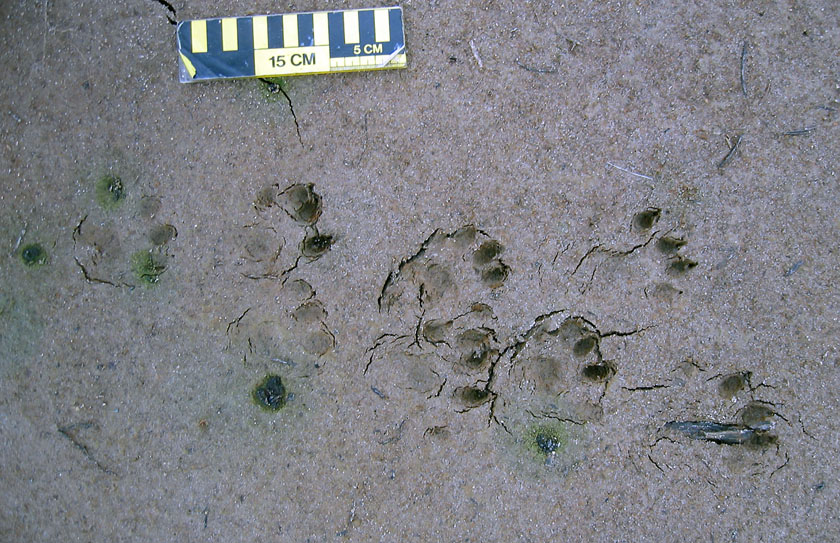 Behold my genius! Only I can clearly see these are the tracks of an eight-legged river otter. Oh, so you think they’re from two four-legged otters, with one following the other? Dolt! Don’t you know who I am?
Behold my genius! Only I can clearly see these are the tracks of an eight-legged river otter. Oh, so you think they’re from two four-legged otters, with one following the other? Dolt! Don’t you know who I am?
So am I the best ichnologist? Not just no, but hell no. The acknowledged master of ichnology is Dolf Seilacher. And the main reason I enthusiastically bestow Dr. Seilacher with a crown of back-filled and spreiten-laden burrows is because of the extraordinary amount of experience he has as an ichnologist. Granted, he’s also done all of that academic-type stuff that persuades far less-accomplished members of tenure-review committees to nod their heads with utmost seriousness and say, “Well, I suppose we can make an exception in this case.” But he also has seen, measured, sketched, journaled, photographed, pondered, argued over many, many trace fossils during his 87 years on this planet. Dolf knows traces.
 Dolf Seilacher, the widely hailed master of ichnology in the world. Even when he’s wrong, he’s really good at it. (Photograph by Anthony Martin, taken in Krakow, Poland.)
Dolf Seilacher, the widely hailed master of ichnology in the world. Even when he’s wrong, he’s really good at it. (Photograph by Anthony Martin, taken in Krakow, Poland.)
So let’s go back to the Ordovician, and how it relates to Dolf and my claim about the importance of experience in ichnology. In 1997, I invited Dolf to visit Emory University as a distinguished speaker in an evolutionary biology lecture series we had then (since gone defunct, like many things at Emory). Because he had never before visited Georgia, he insisted that we also arrange a field trip for him to see some trace fossils here. So with my friend and colleague, Andy Rindsberg, we organized a day trip to an outcrop near Ringgold, Georgia to look at the Ordovician trace fossils there. Andy had done his master’s thesis on the Ordovician and Silurian trace fossils in that area, and as mentioned earlier, I had done my Ph.D. dissertation about the Ordovician rocks, in which I interpreted them mostly through an ichnological lens.
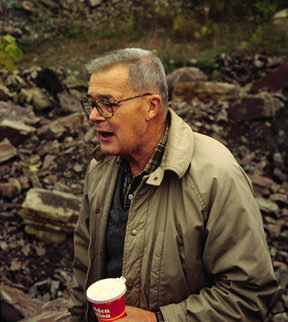 Dolf Seilacher in Georgia (USA) for the first time in November 1997, coffee in one hand and a trilobite burrow in the other. See all of those Ordovician rocks in the background? Even though he’d never been there before, he noticed trace fossils in them in less time than most of us take to read a Huffington Post headline. Gee, you think it had anything to do with his experience? (Photograph by Anthony Martin, taken near Ringgold, Georgia. And just so you know, no paleontologists were “Dolfed” in this photo.)
Dolf Seilacher in Georgia (USA) for the first time in November 1997, coffee in one hand and a trilobite burrow in the other. See all of those Ordovician rocks in the background? Even though he’d never been there before, he noticed trace fossils in them in less time than most of us take to read a Huffington Post headline. Gee, you think it had anything to do with his experience? (Photograph by Anthony Martin, taken near Ringgold, Georgia. And just so you know, no paleontologists were “Dolfed” in this photo.)
Andy and I knew the rocks and their trace fossils at this outcrop better than anyone in the world. Yet within five minutes of arriving at the outcrop, Dolf laid his hand on a large slab of Ordovician rock and began talking matter-of-factly about the trilobite burrows in it. Andy and I looked at each other, and said (almost simultaneously), “Trilobite burrows?”
Dolf was right. This rock and many others there were filled with circular, back-filled burrows, which were made by small trilobites that burrowed into mudflats more than 400 million years ago. During a futile attempt to disprove him the following year, Andy and I found these burrows connected to trackways, and one even ended in a resting trace, perfectly outlining the body of a small trilobite. (Did I mention Dolf was right?)
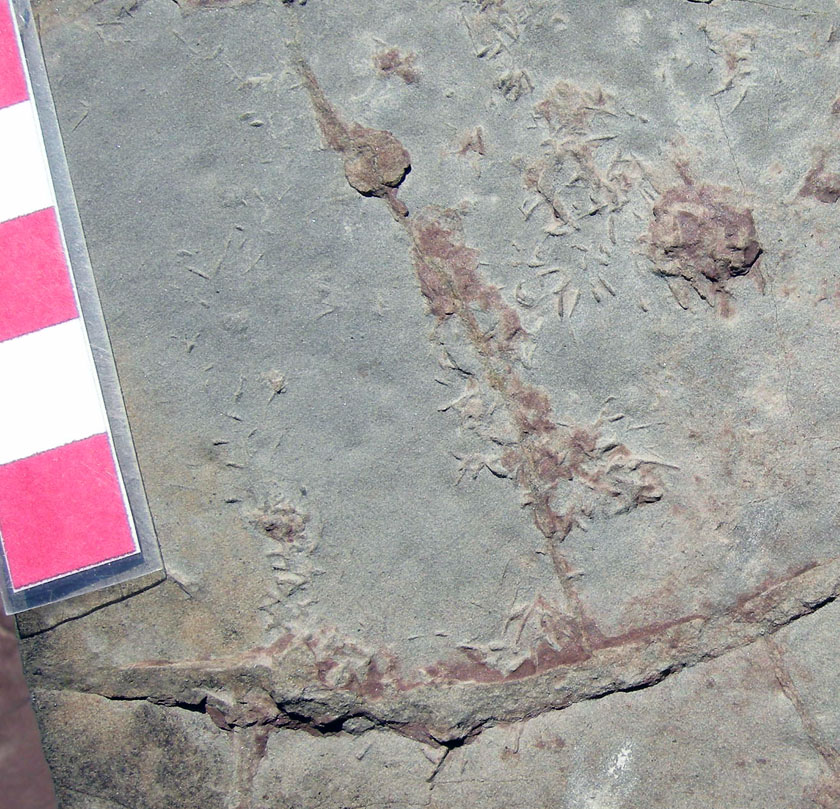 Burrow (upper right, circular structure) connected to tracks made by little legs from a little trilobite. Trace fossils are on the bottom of a sandstone from the Upper Ordovician Sequatchie Formation of northwest Georgia. Scale in centimeters. (Photograph by Anthony Martin.)
Burrow (upper right, circular structure) connected to tracks made by little legs from a little trilobite. Trace fossils are on the bottom of a sandstone from the Upper Ordovician Sequatchie Formation of northwest Georgia. Scale in centimeters. (Photograph by Anthony Martin.)
Later on that same day, we looked more carefully at some other fossil burrows at the outcrop. These broad, banana-shaped trace fossils were ones that Andy and I had noted in our respective studies, called Trichophycus. Dolf continued his trilobite–tracemaker theme, insisting that these were also trilobite burrows. This idea was supported by scratchmarks on the burrow walls, which linked the burrows to the small legs of whichever arthropod lived in the burrows. Again, trilobites made sense as the tracemakers, and we haven’t yet found a reason why this would be wrong.
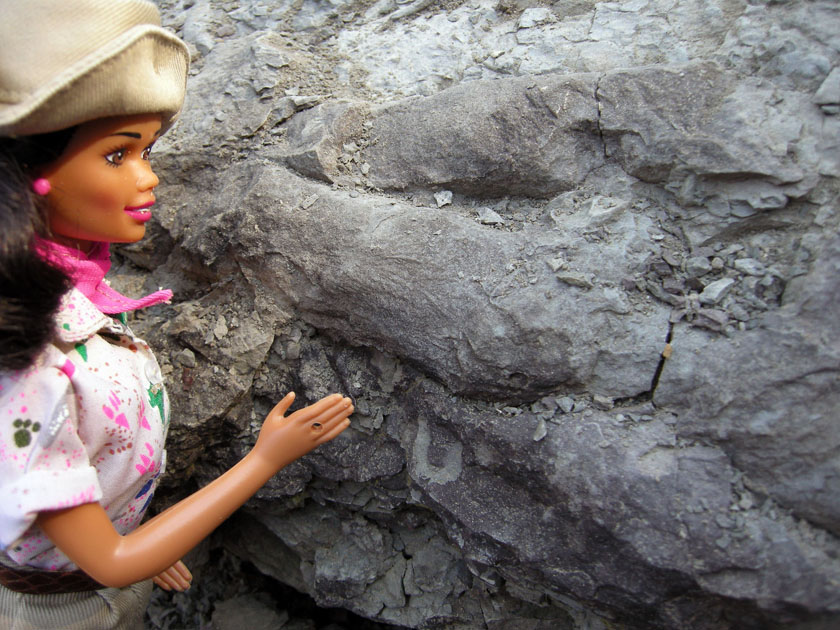 Trusted field assistant Paleontologist Barbie, pointing to a cluster of Trichophycus (interpreted as trilobite burrows) in the Sequatchie Formation of northwest Georgia. She is pointing to some scratchmarks on the burrow walls, which are preserved in natural casts of the burrows. (Photograph by Anthony Martin.)
Trusted field assistant Paleontologist Barbie, pointing to a cluster of Trichophycus (interpreted as trilobite burrows) in the Sequatchie Formation of northwest Georgia. She is pointing to some scratchmarks on the burrow walls, which are preserved in natural casts of the burrows. (Photograph by Anthony Martin.)
Almost 13 years later, in March 2011, Andy and I went back to this same Ringgold outcrop to re-study the trace fossils there, done in preparation for a presentation he gave the next month at a regional Geological Society of America meeting (abstract here). He and I were surprised at how much the outcrop had changed since we last visited. Vegetation, particularly of the thorny variety, covered the ground and impeded our progress. Nonetheless, we found many excellent examples of trilobite burrows (Trichophycus), a beautiful trilobite resting trace (Rusophycus), and, for the first time for either of us, a sea-star resting trace.
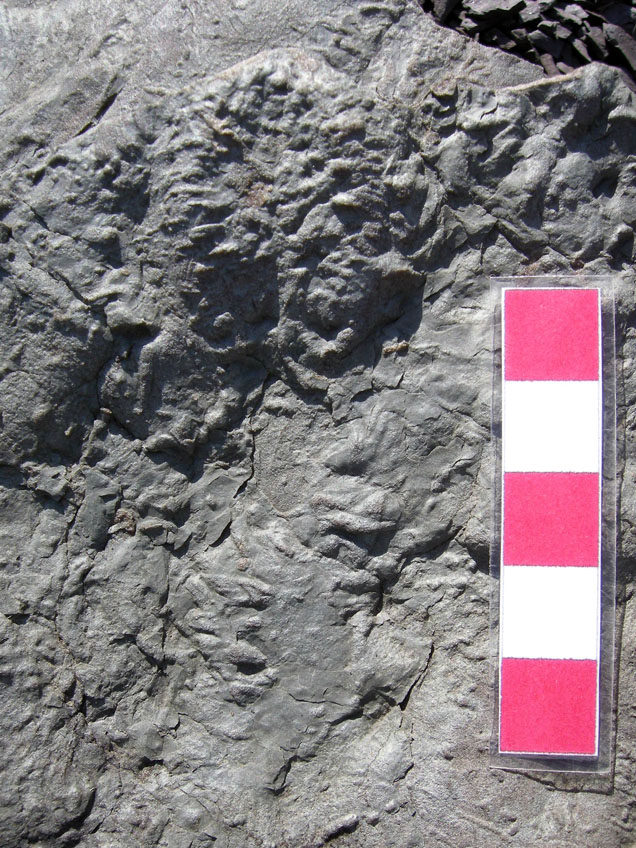 Resting trace of a trilobite (Rusophycus), with a small part of its trackway leading to the trace, in the Upper Ordovician Sequatchie Formation of northwest Georgia. These trace fossils are preserved as natural casts on the bottom of a sandstone, so you’re seeing the underside of where the trilobite hunkered down more than 400 million years ago. (Photograph by Anthony Martin.)
Resting trace of a trilobite (Rusophycus), with a small part of its trackway leading to the trace, in the Upper Ordovician Sequatchie Formation of northwest Georgia. These trace fossils are preserved as natural casts on the bottom of a sandstone, so you’re seeing the underside of where the trilobite hunkered down more than 400 million years ago. (Photograph by Anthony Martin.)
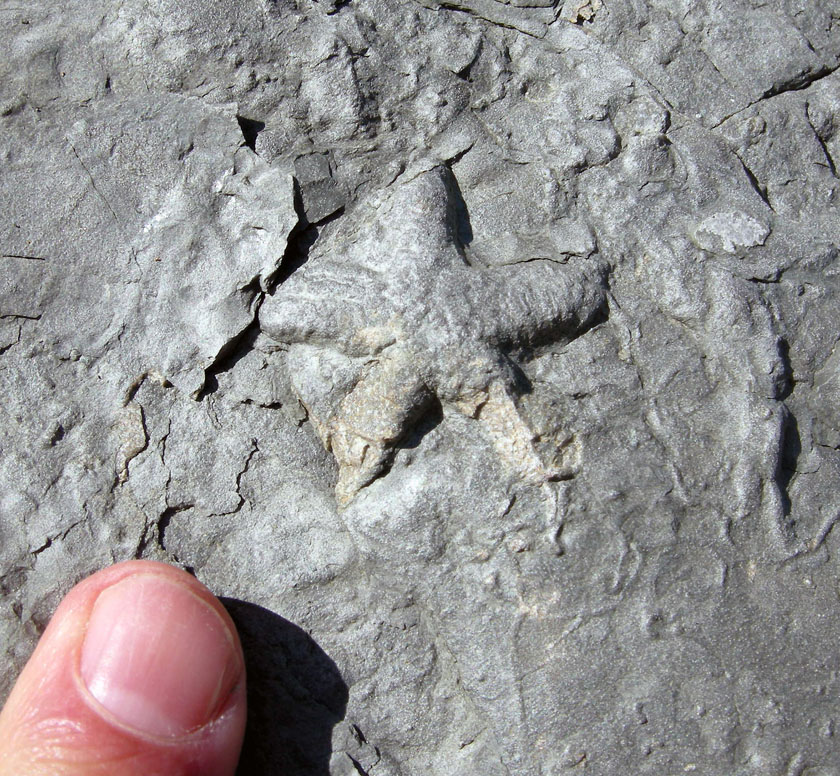 Resting trace of a sea star (Asteriacites) in the Upper Ordovician Sequatchie Formation of northwest Georgia. This trace fossil, like that of the trilobite resting trace, is also preserved as natural casts on the bottom of a sandstone, so you’re looking underneath where the sea star moved into the mud. (Photograph by Anthony Martin.)
Resting trace of a sea star (Asteriacites) in the Upper Ordovician Sequatchie Formation of northwest Georgia. This trace fossil, like that of the trilobite resting trace, is also preserved as natural casts on the bottom of a sandstone, so you’re looking underneath where the sea star moved into the mud. (Photograph by Anthony Martin.)
Our discovery of the latter two trace fossils – the trilobite and sea-star resting traces – took me from the Ordovician to the Georgia coast and back again. Throughout the late 1980s, I recall my Ph.D. advisor, Robert (“Bob”) Frey placing many of his articles in my graduate-student mailbox, all of which dealt with the traces of the modern Georgia coast. That’s odd, I thought. What did the traces of the modern Georgia coast have to do with these 440-million-year-old rocks?
In my limited worldview at the time, I did not see that the Georgia barrier islands and their traces composed a mirror, however removed by time, for looking into that Ordovician past. But eventually, given enough articles read, field work done, and trace fossils examined at these Ordovician outcrops, I slowly realized these 440-million-year-old rocks had been formed in estuaries, similar to those along the Georgia coast. When I first published an article about these rocks and their trace fossils in 1993 (link here), these strata represented the oldest known estuary deposits in the world, and some of the trace fossils could be readily compared to those on the Georgia coast. The beauty of this realization was that Frey, a master ichnologist in his own right and a contemporary of Seilacher, had allowed me to discover it for myself: he just provided the clues.
 Remember that small, circular trilobite burrow with tracks connecting to it? Now compare it to the same sort of traces made by a modern beach mole crab (Albunea paretii), which left its burrow on the right, walked to the left, and is here rapidly burying itself in the sand. Scale in centimeters. (Photograph by Anthony Martin, taken on Sapelo Island, Georgia.)
Remember that small, circular trilobite burrow with tracks connecting to it? Now compare it to the same sort of traces made by a modern beach mole crab (Albunea paretii), which left its burrow on the right, walked to the left, and is here rapidly burying itself in the sand. Scale in centimeters. (Photograph by Anthony Martin, taken on Sapelo Island, Georgia.)
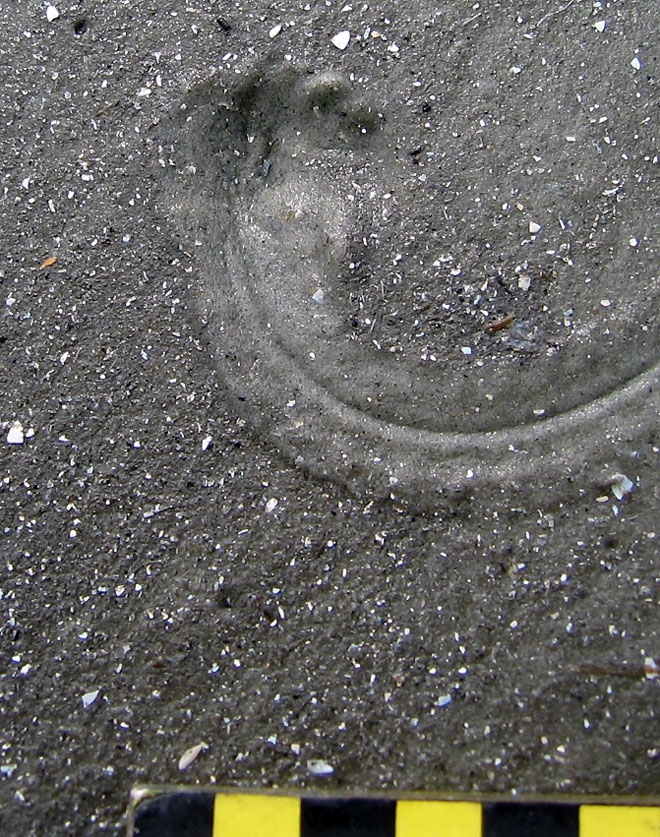 Resting trace and attached trackway of a juvenile horseshoe crab (or limulid, specifically Limulus polyphemus). So think about a similarly sized trilobite making this, and what the bottom of the trace would like like, then compare it to the Ordovician trilobite resting trace fossil shown earlier. Scale in centimeters. (Photograph by Anthony Martin, taken on Sapelo Island, Georgia.)
Resting trace and attached trackway of a juvenile horseshoe crab (or limulid, specifically Limulus polyphemus). So think about a similarly sized trilobite making this, and what the bottom of the trace would like like, then compare it to the Ordovician trilobite resting trace fossil shown earlier. Scale in centimeters. (Photograph by Anthony Martin, taken on Sapelo Island, Georgia.)
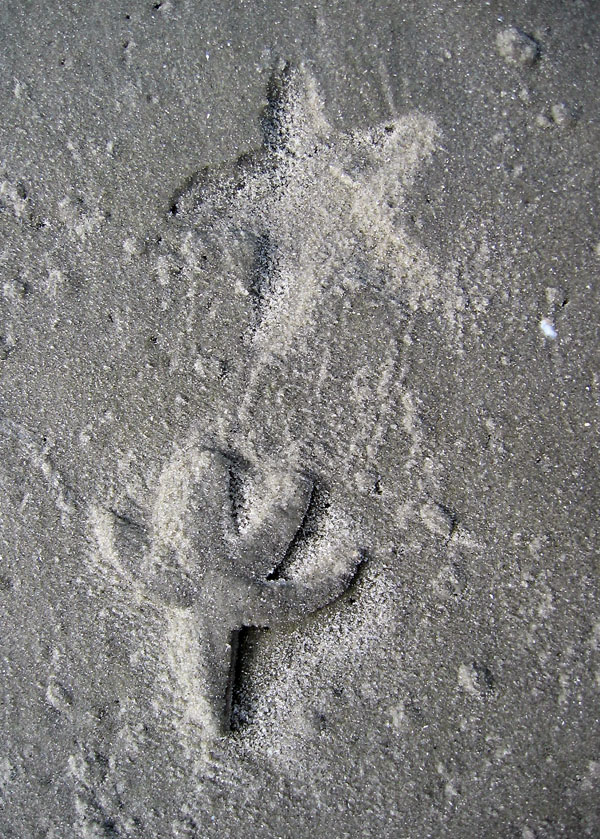 Resting trace of a lined sea star (Luidia clathrata), with the original tracemaker just below its trace. This sea star was stuck above the high tide mark, burrowed into the underlying moist sand, but then tried to move to a better place once its spot started to dry out. Now compare this resting trace to the Ordovician trace fossil shown before. No scale, but sea star is about 8-10 cm wide. (Photograph by Anthony Martin, taken on Sapelo Island, Georgia.)
Resting trace of a lined sea star (Luidia clathrata), with the original tracemaker just below its trace. This sea star was stuck above the high tide mark, burrowed into the underlying moist sand, but then tried to move to a better place once its spot started to dry out. Now compare this resting trace to the Ordovician trace fossil shown before. No scale, but sea star is about 8-10 cm wide. (Photograph by Anthony Martin, taken on Sapelo Island, Georgia.)
The following year and only a month ago (August 2012), Andy and I had another Ordovician learning opportunity presented to us, but this time in Newfoundland, Canada. A day trip to see Ordovician rocks and trace fossils on Bell Island, just a 30-minute ferry ride from St. Johns, Newfoundland, was a welcome break from the butt-numbing sessions of the previous two days of the Ichnia 2012 conference at Memorial University.
In our first few minutes at the outcrop and its numerous boulders – spoil piles from an iron-ore mine – we realized that one of the dislodged slabs in front of me was loaded with specimens of Trichophycus. It was a pleasant surprise to get reacquainted with this trace fossil, and in a place far away both geographically and experientially from Georgia.
 Multiple specimens of Trichophycus in Lower Ordovician rocks of Newfoundland, Canada, preserved as natural casts of the burrows. See all of those scratchmarks on the burrow walls? These were also made by trilobites, but probably different ones from those in Georgia. Scale in centimeters (and that ain’t no real maple leaf.) (Photograph by Anthony Martin.)
Multiple specimens of Trichophycus in Lower Ordovician rocks of Newfoundland, Canada, preserved as natural casts of the burrows. See all of those scratchmarks on the burrow walls? These were also made by trilobites, but probably different ones from those in Georgia. Scale in centimeters (and that ain’t no real maple leaf.) (Photograph by Anthony Martin.)
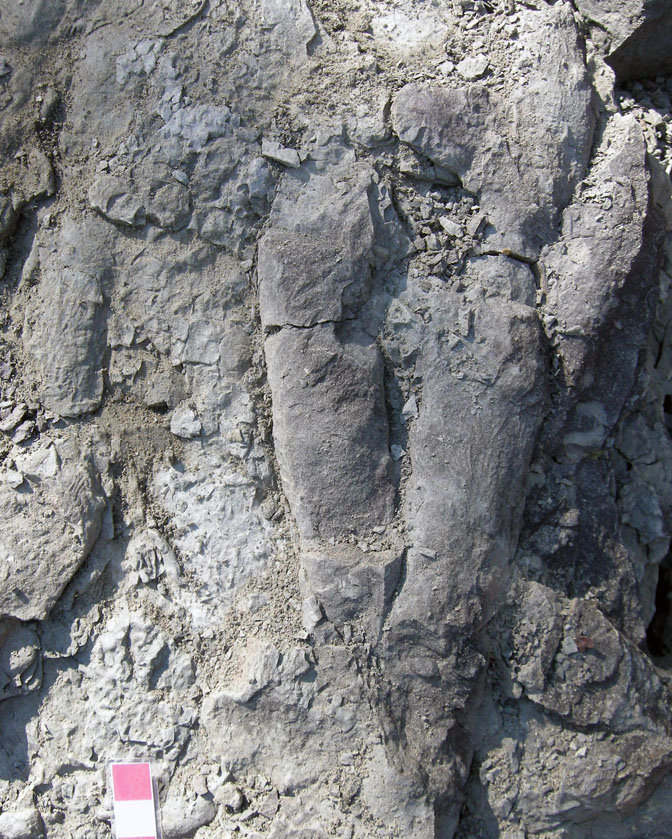 Multiple specimens of Trichophycus in the Upper Ordovician Sequatchie Formation of Georgia, USA, also preserved as natural casts of the burrows and showing some scratchmarks on the walls. Do they look familiar to you, too? If so, welcome to the Ordovician. (Photograph by Anthony Martin.)
Multiple specimens of Trichophycus in the Upper Ordovician Sequatchie Formation of Georgia, USA, also preserved as natural casts of the burrows and showing some scratchmarks on the walls. Do they look familiar to you, too? If so, welcome to the Ordovician. (Photograph by Anthony Martin.)
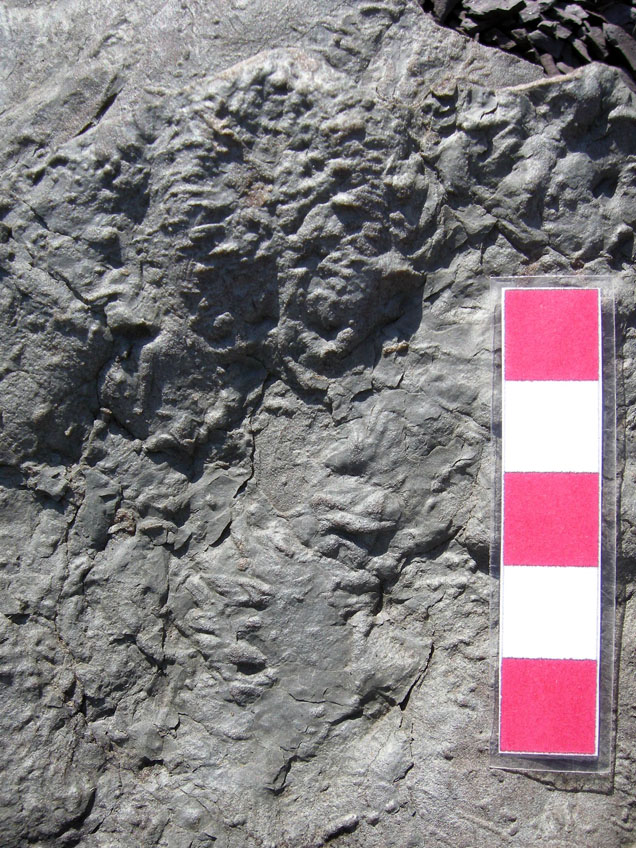 Here’s that trilobite resting trace (Rusophycus) from Georgia that I showed earlier. Now take a gander at the one below…
Here’s that trilobite resting trace (Rusophycus) from Georgia that I showed earlier. Now take a gander at the one below…
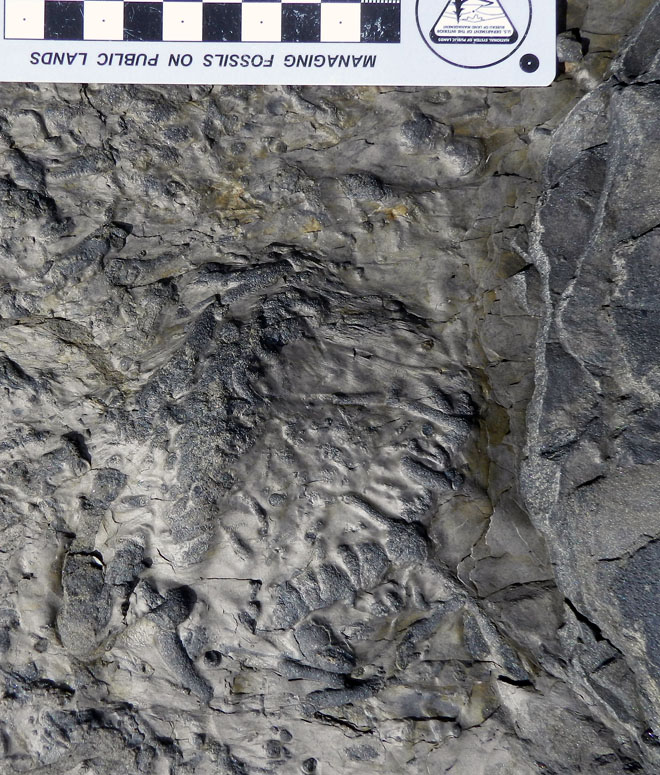 Why, that seems to be a trilobite resting trace (Rusophycus), too, but in Lower Ordovician rocks of Newfoundland. Surprise, surprise, surprise! Scale in centimeters. (Photograph by Anthony Martin.)
Why, that seems to be a trilobite resting trace (Rusophycus), too, but in Lower Ordovician rocks of Newfoundland. Surprise, surprise, surprise! Scale in centimeters. (Photograph by Anthony Martin.)
Suddenly, much of Andy’s and my previous experience with the Ordovician rocks of Georgia came back to us. We were, paradoxically, home, only in this instance, “home” was a time, not a place. Ichnological colleagues who had no idea Andy and I had worked with Ordovician trace fossils stared at us quizzically (and skeptically) as we excitedly discussed the burrows. But once we informed them that we had seen these trace fossils before, our experience was recognized, egos were set aside, and learning was enhanced. Funny how that works sometimes.
So with our trip to Newfoundland, we went from the alien world of the Ediacaran Period, with its trace fossils unlike anything I had seen before, to the more familiar and accommodating Ordovician Period rocks and their trace fossils. What I learned from this trip, combined with many others to Ordovician rocks elsewhere, as well as the modern sediments of the Georgia coast, was that the mirror was not so foggy after all, and that more field experiences can only further clarify these connections between life traces from the present and the not-so-distant past.
Further Reading
Buatois, L.A., Gingras, M.K., MacEachern, J., Mángano, M.G., Zonneveld, J.-P, Pemberton, S.G., Netto, R.G., and Martin, A.J. 2005. Colonization of brackish-water systems through time: Evidence from the trace-fossil record. Palaios, 20: 321-347.
Eldredge, N., 1970. Observations on burrowing behavior in Limulus polyphemus (Chelicerata, Merostomata), with implications on the functional anatomy of trilobites. American Museum Novitates, 2436: 17 p.
Fillion, D. and Pickerill, R.K. 1990. Ichnology of the Lower Ordovician Bell Island and Wabana Groups of eastern Newfoundland. Palaeontographica Canadiana, 7: 1-119.
Martin, A.J. 1993. Semiquantitative and statistical analysis of bioturbate textures, sequatchie formation (upper ordovician), Georgia and Tennessee, USA. Ichnos, 2: 117-136.
Seilacher, A. 2007. Trace Fossil Analysis. Springer, Berlin: 240 p.

